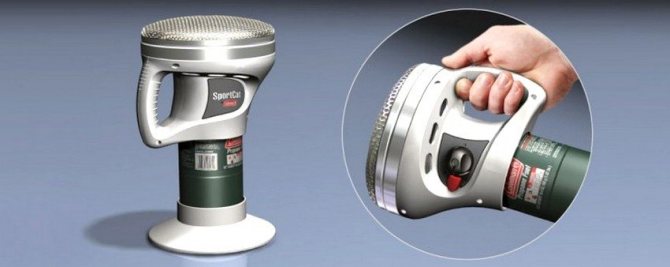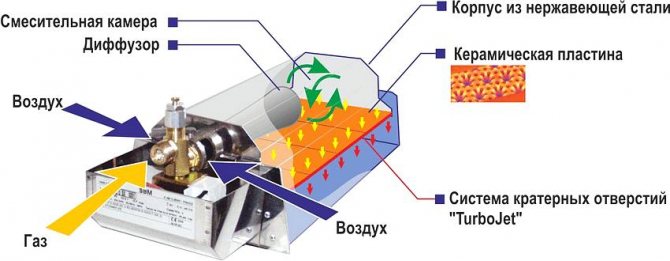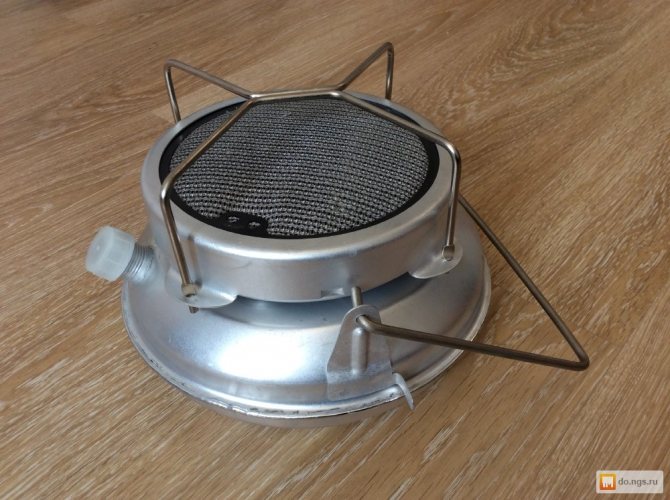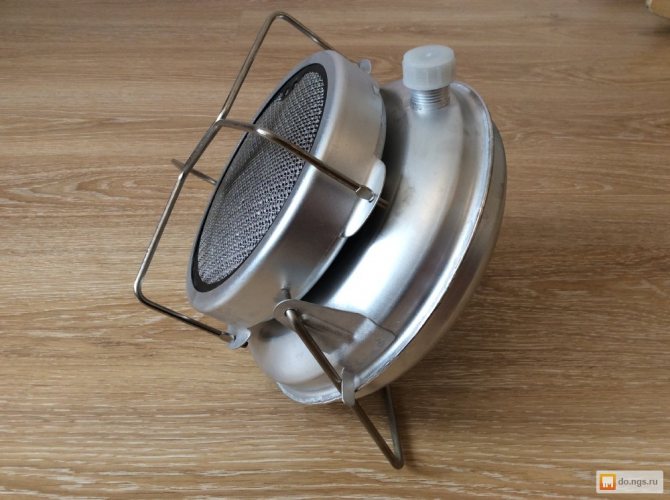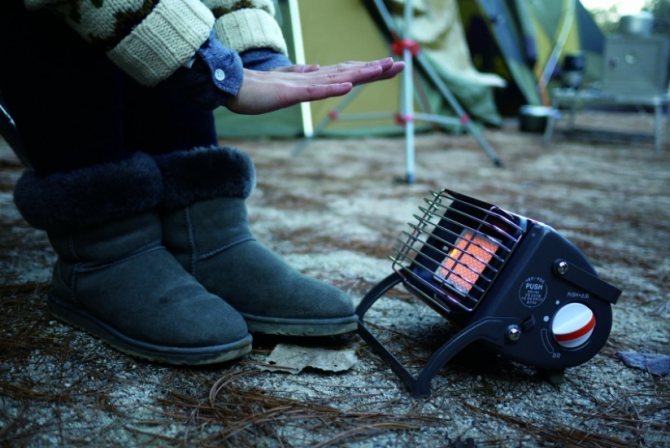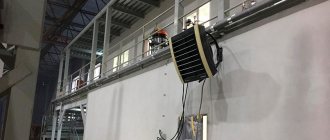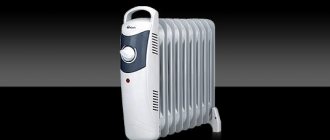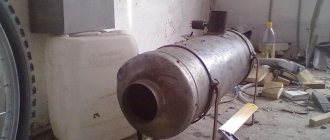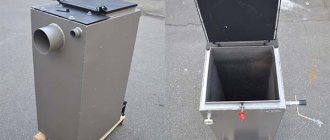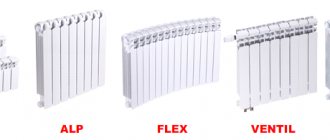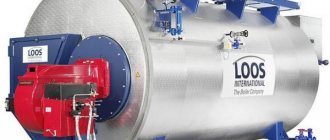The issue of heating is relevant in our area like nowhere else - the rather harsh climate makes us think over heating systems for the home in the cold season. But when it comes to stand-alone systems that do not require large costs and complex installation, many questions arise. Consider one of the most popular options - a catalytic gas heater: advantages, disadvantages, as well as features of use.
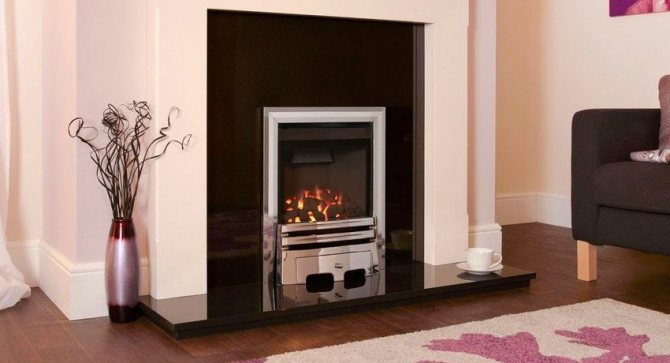
Catalytic gas heater in a country house, stylized as a wood-burning fireplace
Catalytic gas heater: the principle of the device
Catalytic heaters appeared in the vastness of our country relatively recently, but this did not prevent them from occupying a worthy position in the market at the moment. The principle of their operation is fundamentally different from those used in other gas appliances. In the standard scheme, fuel entering the burner is burned, resulting in the release of thermal energy.
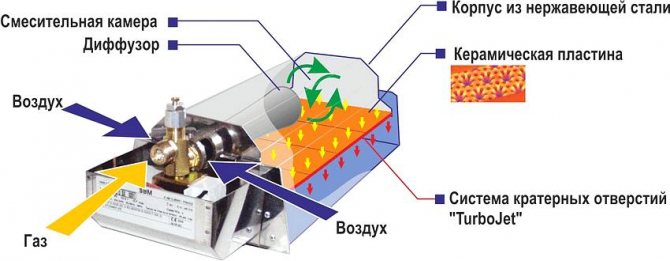

Diagram of a catalytic gas heater
Among the disadvantages of this method of heat production, one can note the fact that a large amount of combustion by-products is released in the process. This negatively affects both the efficiency of the devices and the ratio of oxygen and carbon dioxide in the room. These disadvantages are not typical for catalytic heaters, since their principle of operation is different.
The combustion of fuel in a catalytic gas fired heater does not involve a flame. Instead, the following processes take place:
- when the device is turned on, the catalyst surface begins to warm up. Depending on the selected mode, the temperature can range from 200 to 500 ° C;
- at this time, an air-fuel mixture is prepared in a special chamber;
- liquefied gas enters the heated catalyst plate, which, under the influence of all factors, burns out without forming a flame.
Typically, the plate that is used in catalytic heaters is made of fiberglass with platinum powder added to it. This allows the device to be not only safe, but also environmentally friendly. In addition, the thermal efficiency of such a system is significantly higher than that of standard gas burners, which explains the popularity of these devices.


The principle of operation of a catalytic gas heater
Catalytic fuel combustion: what is it?
Catalytic combustion of fuel is the reaction of oxidation of hydrocarbons in the presence of catalysts. Its main advantage is the absence of an open flame and a relatively low heating temperature of the contact surface, amounting to 150-200 C.
In fact, catalytic combustion makes it possible to obtain a low-temperature infrared heating device that emits heat in a wavelength range that is comfortable for humans.
The catalysts are usually platinum or palladium, the high cost of which has long been the main obstacle to the widespread use of catalytic combustion.
The result (product) of fuel combustion during the catalytic reaction is the same substances as in conventional fuel combustion - carbon dioxide and water CO2 and H2O. However, the process proceeds without excess oxygen, which is of great importance for maintaining comfortable conditions in the room in which the heating device is installed and used. In other words, the catalytic combustion process does not "burn out" the oxygen in the room.
Another advantage of catalytic combustion is the complete combustion of the fuel to the end products of combustion. The formation of an intermediate product of carbon monoxide is excluded.
Devices that generate heat during the catalytic combustion of fuel have been known since the Second World War. They are small metal tanks with openings for air supply and removal of combustion products, inside of which there is a catalyst and cotton wool soaked in alcohol or gasoline. To start such a heater, it is necessary to heat the surface of the catalyst with an open flame and start the combustion process of alcohol vapors.
Then the flame is extinguished, and the process of heat release during the catalytic reaction of burning alcohol continues. During the reaction, the surface of the heating pad heats up to 50-60 C, which allows it to be worn on the body under clothing, warming up in severe frost.
Such heating pads are widely used at the present time in the conditions of expeditions and hikes. It should be noted that high quality alcohol or gasoline is used as fuel for camping heating pads, and the devices themselves are expensive equipment.
Catalytic reaction of combustion of fuel for heating houses and apartments
The widespread use of catalytic combustion for heating houses became possible relatively recently, with the advent of a new technology for the production of a catalytic plate, which allows the deposition of a microscopic layer of platinum on the surface of glass cloth, sufficient to initiate and maintain a catalytic combustion reaction.
An inexpensive, affordable catalyst has allowed a broad look at catalytic combustion and its use for gas combustion.
However, the catalytic reaction of the combustion of hydrocarbons is demanding on the composition of the fuel used. The gas must first be cleaned of harmful impurities that contaminate the catalyst surface and reduce the efficiency of the device. But even these high requirements did not become an obstacle in the development of a new type of heating devices - catalytic gas heaters, which arouse considerable interest among consumers.
Catalytic gas heaters
An example of a catalytic gas heater is a Bartolini Pullover heating device that runs on LPG (bottled liquefied gas). The Bartolini Pullover heater is designed to heat one room.
Gas combustion in the heater takes place on a fiberglass mesh, on the surface of which a layer of platinum is applied. The gas cylinder is installed at the back of the burner. It should be noted that a 27 liter LPG cylinder is included in the delivery set of the device and is an integral part of it. To ensure the safety of the combustion process, the device is equipped with a CO2 concentration sensor. When the level of concentration of combustion products increases, the device automatically turns off.
The main advantage of catalytic gas heaters is the ability to operate the device without using a chimney. However (in accordance with SNiP), during the operation of any gas equipment, it is necessary to ensure the removal of combustion products using a properly working chimney or ventilation system. The second prerequisite is the presence of a constant supply of fresh air.
It should be understood that the combustion process, whether catalytic or conventional, is a fuel oxidation reaction, in which oxygen necessarily participates, and during which carbon dioxide is necessarily produced, the increased concentration of which is dangerous to human health and life.
A catalytic gas heater, unlike other gas heaters, allows you to receive low-temperature heat (150-200 C), which is more comfortable for a person. This is precisely its main advantage.
More and more consumers are interested in spare heat resources in the case when it is not possible to use the main sources of heating. A catalytic (gas or petrol) heater is a progressive novelty among heating devices that has gained popularity in Russia and Europe in a short period of time.
Catalytic heaters are devices that generate heat by oxidation
... For this, a catalyst plate is located in the device housing, when fuel hits it, a reaction occurs, as a result of which heat is generated.
Fuel consumption is carried out in a flameless manner. And this eliminates the formation of combustion products, which makes the device environmentally friendly and safe. In terms of efficiency, the heater bypassed a standard gas burner.
All of these factors explain the growing consumer confidence. Heating takes place according to the following scheme:
- The surface of the catalyst plate is heated from 200 to 500 0 С.
- The fuel-air liquid is heated in a separate chamber.
- The fumes from the combustion of fuel are exposed to the red-hot fiberglass plate.
- Under the influence of a catalyst, a reaction of the so-called flameless combustion takes place.
In other words, the operation of the device is carried out due to oxidation of combustion products
.
Fuel, when it hits the catalyst plate, interacts with it, oxidizes and produces a large amount of energy. Compared to the small size of the heater itself, the amount of heat it produces is impressive.
A standard catalytic device is capable of maintaining heat in a room ranging from 15 to 25 square meters.
The plate will last about seven years
, after which it can be changed in special repair shops, there is no need to buy a new device.
Varieties of catalytic heaters
Catalytic heaters may differ depending on the type of fuel used, as well as some features of operation. Since the internal structure of the heater directly affects its operational characteristics, we will consider the main groups of such devices:
- gas heaters are the most common, but far from the only option. It is based on the process of combustion of a propane-butane mixture. This option is ideal for heating country houses or garages. The most powerful devices can easily heat entire construction sites or warehouses. The maximum power of devices on sale is 4900 W. And although during the operation of the device, the release of harmful impurities and combustion products does not occur, it is worthwhile to use such devices with special attention in rooms whose area is less than 20 m2;
- A gasoline catalytic heater is a device with a pre-built fuel reservoir. It is connected to a catalytic cartridge where gasoline vapors are fed to undergo oxidation. Such models are of modest size, which makes them easy to use when hiking, fishing or hunting;
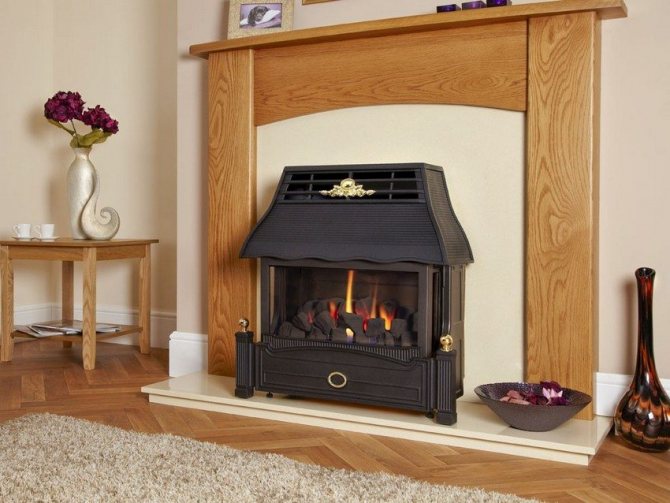

A catalytic gas heater can look very organic in the interior
- heaters operating on dry fuel or industrial alcohol. These are small-sized models, which, like gasoline, are intended for use in the field. Their warmth is only sufficient to cover the minimum needs such as heating food, water, drying clothes and providing warmth inside the tent. Such models are lightweight (about 1-1.5 kg) and small in size. There is always a special compartment inside the structure, into which a container with alcohol or, if necessary, a gas cylinder is installed.
In addition to the basic types, there is one more - catalytic multi-fuel heaters.This type of device is capable of operating on any available fuel - both liquid and gaseous. The power of such a device is usually between 500 and 1200 watts.


Gas fired portable infrared catalytic heaters
Differences from gasoline and multi-fuel models
Gas appliances are the most common, but not the only type of catalytic equipment. Heating units can be operated with other types of fuel.
Depending on this criterion, three more types of devices are distinguished:
- Gasoline... Apparatuses with a built-in fuel tank connected to a catalytic cartridge. Gasoline vapors in them enter the cartridge and undergo oxidation when interacting with the catalyst. Mobility and modest size contribute to the particular popularity of gasoline heaters among outdoor enthusiasts, hunters, fishermen.
- On industrial alcohol... Constructions with a special inner compartment, which holds a container with alcohol or dry fuel. Presented by small-sized models weighing no more than 1.5-2 kg. They are used exclusively in the field: they heat tents, dry clothes, warm up food and drink.
- Multi-fuel... Universal heaters that work with any available fuel, both gaseous and liquid. They are characterized by a rather limited power - 500-1200 watts.
In addition to external characteristics, there are no significant differences between gas, gasoline and multi-fuel catalytic heaters. They all work on the principle of catalytic combustion and have a similar internal structure.


The main advantages of gasoline and multi-fuel models are mobility, compact dimensions, and a relatively affordable price. As for the technical and operational parameters, gas installations surpass them by an order of magnitude.
Gas appliances are easier to maintain, have high performance, and are designed for a wide range of applications.
Gasoline devices are a little more difficult to operate. To ensure efficient and trouble-free operation, they must be refueled with the highest purity gasoline.
Infrared catalytic gas heater for summer cottages
Another parameter by which it is customary to distinguish between catalytic heaters is the presence of an infrared emitter. Models with this addition have a point effect thanks to ceramic panels and reflectors located on the inner surface. This is how heat energy is converted into infrared radiation and gets into the environment.
Such devices, as a rule, have extremely high productivity and operate on gas fuel. Their use is not limited to heating homes. You can often find such heaters on the street: they can be equipped with summer platforms and verandas. Due to infrared radiation, the devices do not consume energy to warm up the surrounding air, but act on the surrounding objects, heating them.
It is difficult to say for sure which gas heater is better: infrared or catalytic without a diffuser. In the second case, the device heats up the air, not objects, which is absolutely inappropriate when it comes to outdoor installation. In any case, it is worthwhile to study the issue of gas catalytic heaters deeper: reviews of each model can be easily found on the network and the appropriate conclusions can be drawn.
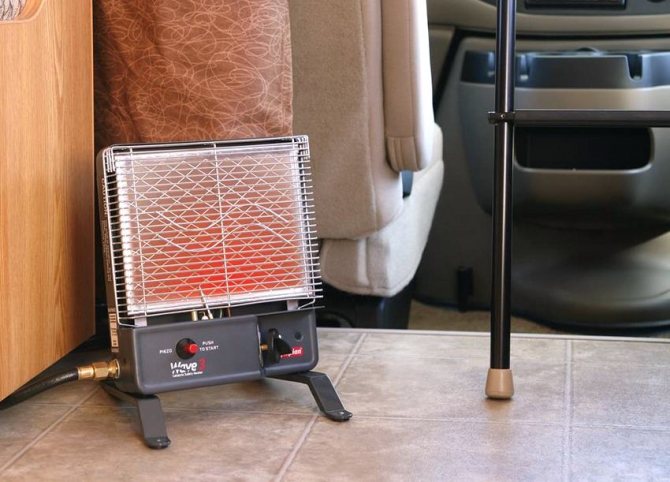

Many models of catalytic heaters are ideal for travel use
What to look for when choosing a catalytic heater
When choosing a heater, you must focus on the main criteria.
Where and how the device will be used
Before buying a heater, you need to clearly understand where exactly and for what purposes it will be used. This is necessary in order to choose the right device according to the type and size of the structure, the type of fuel used.
If you plan to use the heater on hikes, in nature or on travel, then it is better to purchase small-sized types of equipment that are convenient to carry from place to place, and for their operation, no communications are required.
Advantages and Disadvantages of Heating with a Catalytic Heater
Before you buy a catalytic heater, you need to understand all the advantages and disadvantages of this heating method.
Advantages of a catalytic heater:
- a catalytic heater for a summer cottage or home does not adversely affect the microclimate of the room. It does not disturb the natural balance of oxygen and carbon dioxide and does not emit harmful substances that are usually formed during combustion, thus maintaining a healthy microclimate;


Catalytic gas heaters are environmentally friendly and safe devices
- the device is much safer than traditional gas ones, since there is no danger of poisoning as a result of excessive emission of carbon monoxide. In addition, there is no risk of fire. Such a device can be safely used in a house, in a tent, and in an industrial workshop;
- another important advantage is the ability to regulate the power of the device. This allows you not only to maintain a comfortable temperature, but also to significantly save;
- mobility - even large and powerful devices can be easily moved, not to mention compact heaters. According to device owners in reviews, catalytic heaters often fit easily into a bag or backpack.
Despite the abundance of significant advantages, catalytic heaters are not devoid of disadvantages:
- such devices have a rather limited operating period - about 2500 hours. The fact is that during use, the catalyst gradually burns out and after a certain time it must be changed. The amount is approximately 2/3 of the cost of exactly the same new equipment, so it is easier to throw out the old device and purchase a new one;
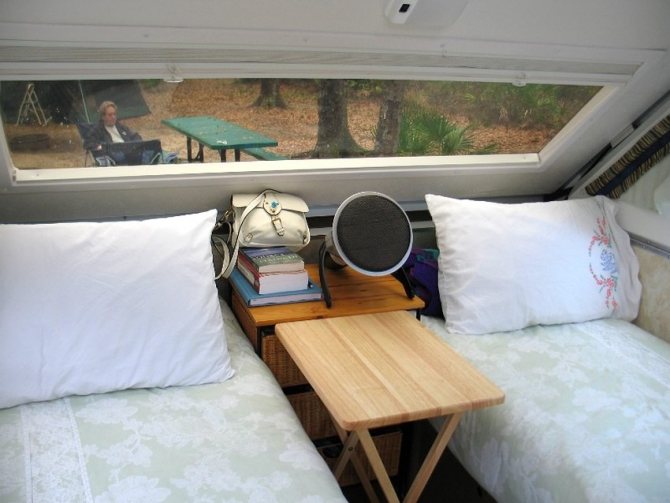

With a small footprint, a portable catalytic heater can easily heat a small room or tent
- the quality and service life of a catalytic heater directly depends on how well the refined fuel you use. Low-quality gasoline or technical alcohol will very quickly render the device unusable.
Catalytic convectors
These devices can operate on electricity, petrol or gas. Their use is optimal for heating a room of 20 "squares" with a power of about 2.9 kW. Gas models are equipped with a fan and are designated "turbo +".
Catalytic combustion is the use of the “surface combustion” principle used for gas flameless burners operating on propane-butane, it is characterized by the absence of a flame. The process takes place as a result of the oxidation of certain organic compounds in the air.


A lot of heat energy is released during combustion, and the glow of the catalyst can be determined by its purple or yellow color. The efficiency is about 80% higher than that of classical devices. Unlike European countries, catalytic convectors have not yet been widely used by domestic consumers.
Due to the presence of wheels, the structure is mobile, so it can be easily moved. The catalytic panel is made of fiberglass.
Catalytic heater for summer cottages and homes: safety of use
If you are thinking about whether it is worth buying a catalytic heater for a summer cottage or at home, the safety of the device will probably be the most important selection criterion.
There is a misconception that catalytic gas fired heaters can be unsafe and can put the lives and health of users at risk. In fact, this is not the case. Of course, as with any appliance, safety precautions must be followed with a catalytic heater to minimize potential risks.
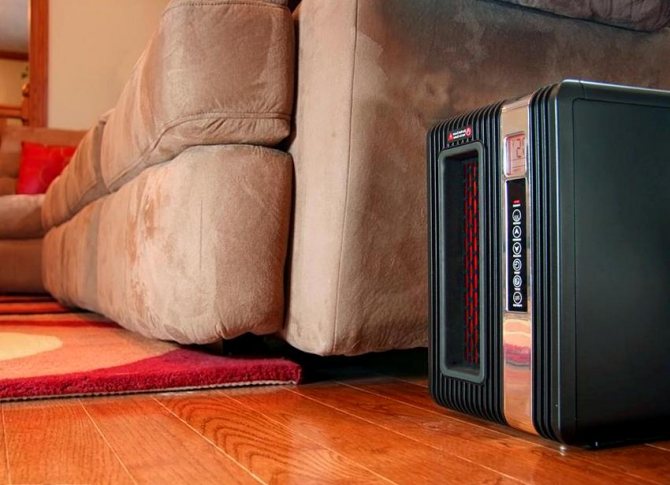

Infrared long-wave radiation not only does not harm human health, but can also have a positive effect
As for the impact of this heater on the human body, we can say with confidence the following: carbon monoxide is not formed as a result of the oxidation process and, accordingly, does not accumulate in the room. This means that there is no risk of getting poisoned. In the case of using infrared radiation, exclusively long waves are used, which are not only not harmful, but even useful.
Which gas heaters for the home are better - types, features, selection rules
Gas heaters for private households and summer cottages have a high efficiency rate and a decent appearance. They can be installed both in large rooms and in small rooms. The choice of these devices in terms of power is wide. They also have a gas supply regulation.
If the property is located outside the city limits, you cannot do without a heater. The use of gas appliances is a good option for generating heat during the off-season, but sometimes in the summer there is a need to heat the room.


All gas heaters have:
- body;
- burner;
- heat exchanger;
- a heating element.
Thanks to the presence of a thermostat, an automatic shutdown function and other options, gas heaters are comfortable to use. The heat from the convectors is dissipated by heating the heat-conducting elements.
Depending on the method of implementation, convectors are:
The gas convector is considered the leader among heating devices for suburban buildings. Outwardly, it resembles a radiator, it is mounted under the window, like a heating panel. Gas heaters for the home operate on liquefied gas in cylinders or they are connected to a centralized line.
Gas appliances differ from a boiler with a similar performance by the creation of a pipeline. To ensure the operation of the unit around the perimeter of the structure, it is necessary to lay pipes and install radiators in the premises. The use of convectors does not require the implementation of such measures - they are installed autonomously.
The most popular brands and models of catalytic gas heaters
There are not so many companies that offer really high-quality products on the heating equipment market. Therefore, when choosing a suitable option for yourself, you should pay attention to reputable manufacturers. Let's try to figure out the devices of which companies are the most popular, and also consider the features of some models of these manufacturers.
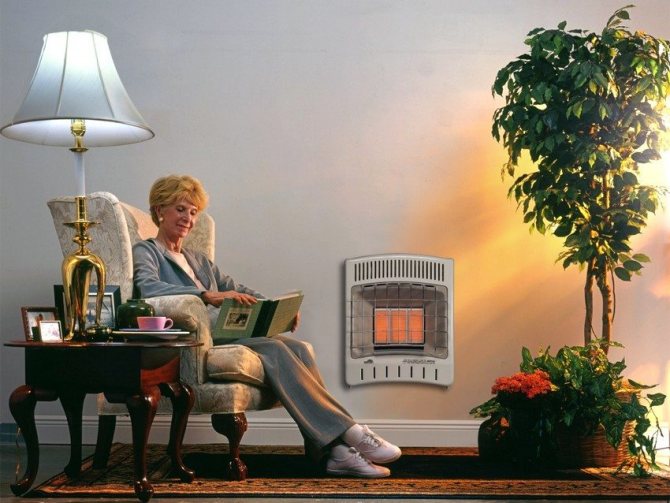

The ability to adjust the power of the device allows you to maintain a comfortable temperature in the room, as well as save money
Bartolini gas catalytic heaters
The heating equipment of the famous Italian brand Bartolini is very popular in Russia. By releasing rather powerful devices (from 2900 to 4200 W), this company provided heat to many homes. The manufacturer made the main emphasis on the complete independence of the devices from the presence of any communications. All models run on liquefied gas.
Popular Bartolini catalytic gas heaters:
| Model name | Characteristics | Dimensions, weight | price, rub. |
| Bartolini pullover k turbo plus |
| 780x430x420 mm 13.5 kg | 15750 |
| Bartolini pullover k |
| 780x430x420 mm 13.5 kg | 11480 |
| Bartolini pullover i |
| 780x430x420 mm 13.5 kg | 13200 |
| Bartolini primavera k |
| 780x430x420 mm 13.5 kg | 11480 |
The most popular among the presented models is the Bartolini pullover k gas catalytic heater. Reviews about him are the most positive, and the cost of this device is one of the most affordable. At the same time, if you need to heat a room that exceeds the standard 35 m2 for these devices, you can purchase Bartolini pullover i. It has great power, and can easily heat about 50 m ?.


In the production of heating equipment, Bartolini focuses on the complete independence of devices from the presence of any communications.
Which gas catalytic heater to choose: Bartolini pullover k, Bartolini pullover i or any other of the proposed options, it is worth deciding based on personal preferences and operating conditions of the room that is supposed to be heated. In any case, there is no doubt about the quality and reliability of devices from this manufacturer.
Heating equipment of the Campingaz company
The second most popular place is confidently taken by Campingaz. For more than 60 years, this French company has been producing all kinds of equipment, mainly gas. The company focuses on ensuring the most comfortable stay in nature at any time of the year. And an excellent example of this is the Campingaz cr 5000 turbo gas catalytic heater.
The maximum power of this heater is 3000 W, while the device is equipped with its regulator and piezo ignition. The device is quite economical - when used at maximum power, fuel consumption is no more than 0.2 kg / h.
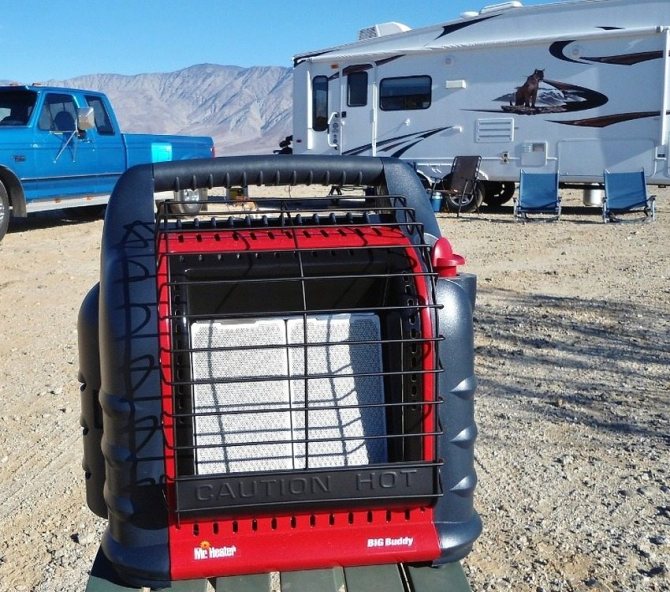

When choosing catalytic gas equipment, it is important to consider in what conditions it will be used.
Kovea gas catalytic heaters
The Korean company Kovea closes the top three among foreign manufacturers, whose gas heaters are popular today. This company is ready to offer its customers a wide variety of models, as well as, as an addition to them, a special refined fuel.
A table with the characteristics of the three best models of Kovea heaters:
| Model name | Characteristics | Dimensions, weight | price, rub. |
| Kovea KH-2006 |
| 25x24x23 cm packed 1.4 Kg | 6460 |
| Kovea KH-0203 |
| 34x28x19 cm packed; 2.1 kg | 10130 |
| H-0710 Fire Ball |
| 190x180x190 mm 565 g | 6233 |
Argo gas catalytic heater
If you wish to purchase an even more budgetary heater, you should pay attention to the domestically produced Argo gas catalytic heater. This device is widely used for heating verandas, garages, as well as industrial premises, where there is a sufficiently high level of air circulation. This device cannot be used in small or confined spaces.
Most often, the Argo heater is used when it is necessary to maintain a high temperature in a greenhouse or shed where animals are located. Many farmers use it to grow their produce.
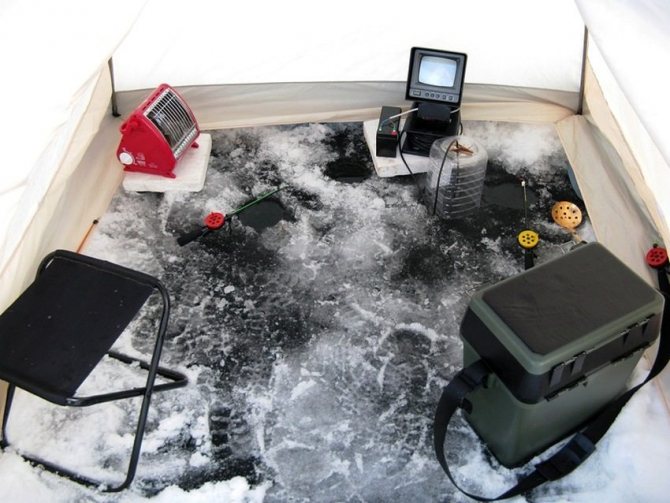

Portable catalytic gas heaters are popular with fishermen and outdoor enthusiasts.
The device also runs on liquefied gas, which enters it from a cylinder through a special hose. The volume of the connected cylinder can be from 5 to 15 liters. With a power of 2900 W, the device consumes only 0.25 kg / h of gas, burning it on a panel heated to 800-900 ° C. At the same time, the percentage of emitted carbon dioxide does not exceed 0.01%.Nevertheless, as mentioned above, it is not recommended to use this heater in poorly ventilated rooms.
The device is small in size, but significant in weight. With dimensions of 420x330x210 mm, its weight is 6.7 kg, which makes it difficult to move over serious distances. However, for stationary use, the Argo heater is a perfectly suitable option. Moreover, you can buy such a model for only 2100 rubles.
Review of the best manufacturers
An extensive range of catalytic heaters is represented by various imported and domestic brands. Consider several manufacturers whose products are recognized by consumers as the best in this area.
No. 1 - reliable and functional Bartolini devices
Heating equipment of the Italian brand Bartolini is the most in demand on the market. The company produces rather powerful devices with a performance from 2900 to 4200 W, working on liquefied gas.
The main emphasis in production is placed on the independence of the equipment from the availability of communications.
Heaters from the Italian manufacturer can be purchased at a price of 11 to 18 thousand rubles. They are distinguished by good quality, reliability, economical fuel consumption.
Most of them have CO2 monitoring sensors, rollover shutdown systems. The model is especially in demand among buyers. Bartolini pullover k.
# 2 - compact and economical models from Campingaz
The next most popular company is Campingaz. This French company produces efficient and safe gas heaters for residential, warehouse, retail and industrial premises. Special attention is paid to portable equipment that provides a comfortable stay in nature.
The brand's devices provide excellent heat transfer and have European quality certificates. New technologies of economical fuel consumption are used in their production.
The average cost of products is 11 thousand rubles. The best representative of the range is considered Campingaz cr 5000 turbo.
No. 3 - comfortable and safe heaters from the Kovea brand
The Korean company Kovea offers customers gas heaters of various designs. Mostly these are compact portable models of low power, operating on the basis of infrared radiation.
The Korean manufacturer practically does not use plastic elements in the design of its devices, which further increases the safety of operation. The average price of products is 5-8 thousand rubles.
No. 4 - inexpensive and durable heaters from Argo
The budget version of the catalytic heater is offered by the domestic manufacturer Argo. The gas heat generator of this company is designed for heating industrial premises, garages, verandas with normal air circulation. Farmers often use it in greenhouses, sheds.
With not too large dimensions, the weight of the device is 6.7 kg. There are no wheels in it, so it is rather difficult to move it over long distances. But for stationary use, it is quite suitable. The approximate cost of the device is 2000 rubles.
Does the catalytic version of the device seem unreasonably expensive to you as a temporary heater for a summer residence? We recommend that you familiarize yourself with other gas appliances suitable for heating temporary premises.
How to choose and buy a catalytic gas heater
Buying any device, including a catalytic heater, requires attention. You need to imagine as accurately as possible: where, in what conditions and how often you plan to use the acquisition. When choosing, it is important to take into account both the price of a gas catalytic heater and reviews of real buyers about this model.
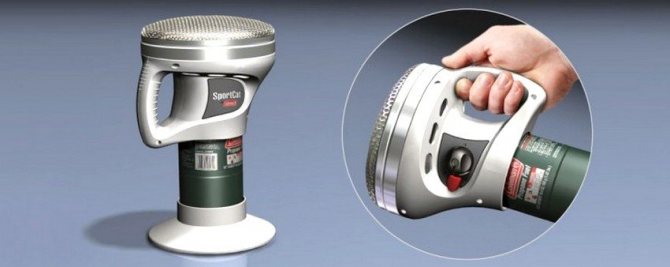

Many models of catalytic heaters are convenient to take on a hike or trip due to their small size and light weight
The parameters specified by the manufacturer will help to determine the required power of the device. The packaging usually contains information about the maximum area the heater can cover.
Gas catalytic cylinder heaters have recently appeared on the market. However, the convenience of their use, as well as a high level of safety and environmental friendliness, quickly made them popular not only among outdoor enthusiasts, but also among those who simply want to heat their country house or garage with high quality. Such devices are highly efficient, affordable and are excellent for use in almost any environment.
Advantages and disadvantages
The positive characteristics of catalytic heaters include:
- Compact volumes
and low weight: the medium-sized device fits easily into the trunk of a car. - Security Mode
... The devices are able to monitor the level of carbon dioxide in the room. In addition, as mentioned, they do not have a flame, which excludes the possibility of a fire. - The devices are very economical
... Gas appliances consume about 200 grams in about an hour when operating at full power. - Fuel availability
... A new bottle or a couple of liters of gasoline can be purchased at any gas station. - No unpleasant odors
... The devices do not spoil the air with combustion products. - Simple device
... There are no complicated mechanisms, everything is clear and simple.
The disadvantages include only the high cost, especially for models with high power.
But this is not surprising, heaters with reliable fire protection, helping out in the cold outside the house, have no competitors. Catalytic heaters have firmly taken their place.
The world of modern household appliances is quite diverse, and when there is plenty to choose from, a problem arises. If we talk about heating devices, then, of course, I would like to purchase a heater that will be convenient, efficient, safe, and even beautiful to boot.
It is impossible to consider absolutely all types of devices in one article, therefore we will describe only the features of the catalytic heater.
Varieties
All gas heaters are divided into portable and stationary.
The former are usually used temporarily, that is, from time to time. They are small in size and weight, most often placed on the floor. Their performance, of course, is less.
Such gas heaters are usually chosen for utility rooms or for summer cottages, as well as in the absence of a main gas supply. Such a unit will not withstand a full and constant heating of a residential building.
The second (stationary) gas heaters are devices operating from main or cylinder gas. These devices are installed only in a permanent place and will quite cope with the winter heating of the house. These heaters are large, powerful and require additional equipment as a chimney.
Choice
If you come to the dacha sporadically in winter, and do not live there permanently, it makes no sense to install a heating boiler, install convectors throughout the house or build a stove. It is more profitable to buy a gas heater for a summer residence that works offline. It heats up the space quickly when needed. The device is selected taking into account the following factors:
- Application frequency. If you plan to come to a country house 2-3 times a year to celebrate the New Year or Birthday in a narrow circle, a heater will do power up to 3 kW, warming up a room up to 20 m2 to a comfortable temperature of 20 degrees in 2-3 hours. A standard 12-15 liter bottle is enough for a day or two.
- Heating area. For a room of no more than 20 m2, a unit with a capacity of up to 3 kW is suitable. For a larger area - 5-8 kW.
- Security. There must be automatic safety devices. Carbon dioxide will be released during combustion.Choose a model equipped with a special control sensor CO2 content in the air. If the permissible concentration is exceeded, such a device will turn itself off. Sensors for monitoring the burner flame level and overheating of the device itself are also important.
To prevent spontaneous combustion, the device is equipped with an automatic valve system. Control and automation make the operation of the device safer and more independent from the constant presence of a person.
Devices with electronics are more expensive but this is the safety of the family, on which it is not necessary to save.
Attention is drawn to the appearance and service. The device will stand in plain sight, so it is better to choose it according to the design so that it harmoniously fits into the interior.
Before going shopping, they usually find out which type is preferable and why. Pay attention to the parameters of the home and the frequency of being in the country in winter, as well as the rating of gas heaters. It is undesirable to blindly follow the advice of a friend who bought the device for his own reasons and with characteristics suitable specifically for his home. This may not suit you.
TOP-5 autonomous heating devices:
- Bartolini Pullover K. Catalytic, power 3 kW, fuel - compressed propane-butane, does not emit CO2. There is a flame level control sensor, auto shutdown when falling, a controller for the concentration of carbon dioxide in the air. Equipped with piezo ignition, heating power regulator, silent at work. Of the minuses - large size, cost.
- Timberk Ceramic Infrared Gas Heater. Power 4.2 kW, easy to move thanks to the presence of wheels, runs on propane-butane, 12 liter cylinder included in the package. CO2 concentration monitoring sensors, roll-over protection. The power is regulated, the ignition is automated. Inexpensive.
- Infrared gas heater NEOCLIMA UK-20. Power 4.2 kW, weight about 9 kg. As safe as possible during operation, it is equipped with sensors for fire, oxygen content in the room and position in space. Suitable for rooms with a volume of up to 80 m3. Average price.
- BALLU BIGH-55. Infrared type, can work from 27 liter cylinders with propane-butane and pressure up to 3.7 kPa. Equipped with automation responsible for the safety of work, piezo ignition, has 3 operating modes, designed for heating rooms up to 60 m2.
- TIMBERK TGH 4200 Infrared Ceramic M1. The price is above average. Economical, runs on a 15 liter propane-butane cylinder. Equipped with sensors safety: flame control, tilt of the device, CO2 content, shut-off of the fuel supply if necessary.
Today, an increasing number of consumers are abandoning expensive methods of heating a country house if it is used mainly in the summer, or there is no infrastructure in the location. In such cases, an autonomous, properly selected gas heating source will be a good way out of a difficult situation and provide comfort in any weather.
Choosing the optimal heater
When choosing a suitable heater, it is necessary to take into account many nuances, evaluate the convenience of design, functionality, additional features and equipment of the model you like. Consider the main criteria for making the right choice.
Criterion # 1 - place and conditions of use
The first step is to decide on the purposes for which you plan to buy a catalytic device. The optimal type of design and the set of characteristics required in this case depend on where and in what conditions the apparatus will be used.
The main indicators should be selected taking into account the conditions of the upcoming operation, the parameters of the heated object. It is necessary to take into account the expected frequency of application, heating area, preview reviews of real buyers about the model.
So, for space heating, it is worth buying larger heaters with sufficient power and automatic safety sensors. If the device will need to be repositioned frequently, it is better to choose a mobile design on wheels.
Criterion # 2 - technical characteristics
One of the main parameters of a heater is power. To choose a device with the correct performance, you should perform preliminary calculations, consult with the seller, and carefully study the instructions. The technical documentation should indicate the area for which the power of a particular model is calculated.
Is there any harm from catalytic emitters?
Perhaps someone would think that such heaters are unhealthy. But this is completely wrong. Catalytic heaters are not hazardous to human and animal health. Of course, during work, all safety measures that will be indicated in the instructions should be followed.
Safety is guaranteed by the following factors:
- Infrared radiation uses waves of a special low spectrum, which have a positive effect on a person;
- The heater uses combustion of fuel without flame due to oxidation. This means that carbon monoxide vapors will not accumulate in the house.
Catalytic heaters have recently been on the market. You can buy a catalytic heater from a specialist store or online. This system became very popular thanks to outdoor enthusiasts... Heaters like these heat tents or even large construction sites very well. Catalytic heaters are very efficient and can be used in large living areas.




